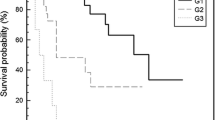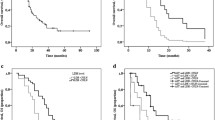Abstract
The evaluation of prognosis is essential for the management of a patient with a neuroendocrine tumor, especially digestive, in which the risk of malignancy is significant. Three validated histoprognostic factors are available from the pathological examination: morphological differentiation status, histological grade, and pTNM stage. Numerous prognostic biomarkers have been proposed in the literature but none has been transposed to clinical practice. In the sameway, among the candidate predictive biomarkers, only MGMT is an emerging biomarker, which may be useful for the prediction of the response to temozolomide.
Résumé
L’évaluation du pronostic est un élément essentiel pour la prise en charge d’un patient atteint de tumeur neuroendocrine, notamment digestive, où le risque de malignité est important. Les trois facteurs histopronostiques validés susceptibles d’être fournis par l’examen anatomopathologique sont: le degré de différenciation morphologique, le grade histologique et le stade pTNM. De nombreux biomarqueurs pronostiques ont été proposés, mais aucun n’a été validé en pratique clinique. C’est aussi le cas pour les marqueurs prédictifs, parmi lesquels seule la MGMT fait figure de marqueur émergent pour la prédiction de la réponse au témozolomide.
Similar content being viewed by others
Références
Andersson E, Sward C, Stenman G, et al. (2009) High-resolution genomic profiling reveals gain of chromosome 14 as a predictor of poor outcome in ileal carcinoids. Endocr Relat Cancer 16: 953–966
Couvelard A, Deschamps L, Ravaud P, et al. (2009) Heterogeneity of tumor prognostic markers: a reproducibility study applied to liver metastases of pancreatic endocrine tumors. Mod Pathol 22: 273–281
Dhall D, Mertens R, Bresee C, et al. (2012) Ki67 proliferative index predicts progression-free survival of patients with well-differentiated ileal neuroendocrine tumors. Hum Pathol 43: 489–495
Ekeblad S, Skogseid B, Dunder K, et al. (2008) Prognostic factors and survival in 324 patients with pancreatic endocrine tumor treated at a single institution. Clin Cancer Res 14: 7798–7803
Jann H, Roll S, Couvelard A, et al. (2011) Neuroendocrine tumors of midgut and hindgut origin: tumor-node-metastasis classification determines clinical outcome. Cancer 117: 3332–3341
Jiao Y, Shi C, Edil BH, et al. (2011) DAXX/ ATRX, MEN1, and mTOR pathway genes are frequently altered in pancreatic neuroendocrine tumors. Science 331: 1199–1203
Kloppel G, Couvelard A, Perren A, et al. (2009) ENETS Consensus Guidelines for the Standards of Care in Neuroendocrine Tumors: towards a standardized approach to the diagnosis of gastroenteropancreatic neuroendocrine tumors and their prognostic stratification. Neuroendocrinology 90: 162–166
Kulke MH, Hornick JL, Frauenhoffer C, et al. (2009) O6-methylguanine DNA methyltransferase deficiency and response to temozolomide-based therapy in patients with neuroendocrine tumors. Clin Cancer Res 15: 338–345
Marion-Audibert AM, Barel C, Gouysse G, et al. (2003) Low microvessel density is an unfavorable histoprognostic factor in pancreatic endocrine tumors. Gastroenterology 125: 1094–1104
Mitry E, Baudin E, Ducreux M, et al. (1999) Treatment of poorly differentiated neuroendocrine tumours with etoposide and cisplatin. Br J Cancer 81: 1351–1355
Modlin IM, Oberg K, Chung DC, et al. (2008) Gastroenteropancreatic neuroendocrine tumours. Lancet Oncol 9: 61–72
Panzuto F, Boninsegna L, Fazio N, et al. (2011) Metastatic and locally advanced pancreatic endocrine carcinomas: analysis of factors associated with disease progression. J Clin Oncol 29: 2372–2377
Pizzi S, D’Adda T, Azzoni C, et al. (2002) Malignancy-associated allelic losses on the X-chromosome in foregut but not in midgut endocrine tumours. J Pathol 196: 401–407
Rindi G, Falconi M, Klersy C, et al. (2012) TNM staging of neoplasms of the endocrine pancreas: results from a large international cohort study. J Natl Cancer Inst 104: 764–777
Rindi G, Klimstra DS, Arnold R, et al. (2010) Nomenclature and classification of neuroendocrine neoplasms of the digestive system. In: Bosman FT, Carneiro F, Hruban RH, Theise ND (eds) WHO classification of Tumours of the Digestive System. IARC, Lyon, pp. 13–14
Rindi G, Kloppel G, Alhman H, et al. (2006) TNM staging of foregut (neuro)endocrine tumors: a consensus proposal including a grading system. Virchows Arch 449: 395–401
Rindi G, Kloppel G, Couvelard A, et al. (2007) TNM staging of midgut and hindgut (neuro) endocrine tumors: a consensus proposal including a grading system. Virchows Arch 451: 757–762
Scarpa A, Mantovani W, Capelli P, et al. (2010) Pancreatic endocrine tumors: improved TNM staging and histopathological grading permit a clinically efficient prognostic stratification of patients. Mod Pathol 23: 824–833
Sobin LH, Gospodarowicz MK, Wittekind C (2009) TNM Classification of Malignant Tumours, 7th Edition. Wiley, New York
Strosberg JR, Cheema A, Weber J, et al. (2011) Prognostic validity of a novel American Joint Committee on Cancer Staging Classification for pancreatic neuroendocrine tumors. J Clin Oncol 29: 3044–3049
Strosberg JR, Weber JM, Feldman M, et al. (2013) Prognostic validity of the American Joint Committee on Cancer Staging Classification for midgut neuroendocrine tumors. J Clin Oncol 31: 420–425
Tang LH, Gonen M, Hedvat C, et al. (2012) Objective quantification of the Ki67 proliferative index in neuroendocrine tumors of the gastroenteropancreatic system: a comparison of digital image analysis with manual methods. Am J Surg Pathol 36: 1761–1770
Yachida S, Vakiani E, White CM, et al. (2012) Small cell and large cell neuroendocrine carcinomas of the pancreas are genetically similar and distinct from welldifferentiated pancreatic neuroendocrine tumors. Am J Surg Pathol 36: 173–184
Yang Z, Tang LH, Klimstra DS (2011) Effect of tumor heterogeneity on the assessment of Ki67 labeling index in well-differentiated neuroendocrine tumors metastatic to the liver: implications for prognostic stratification. Am J Surg Pathol 35: 853–860
Zhang L, Smyrk TC, Oliveira AM, et al. (2009) Kit is an independent prognostic marker for pancreatic endocrine tumors: a finding derived from analysis of islet cell differentiation markers. Am J Surg Pathol 33: 1562–1569
Author information
Authors and Affiliations
Corresponding author
About this article
Cite this article
Scoazec, J.Y. Problématique des marqueurs histopronostiques dans les tumeurs neuroendocrines digestives. Oncologie 15, 510–514 (2013). https://doi.org/10.1007/s10269-013-2332-4
Received:
Accepted:
Published:
Issue Date:
DOI: https://doi.org/10.1007/s10269-013-2332-4




